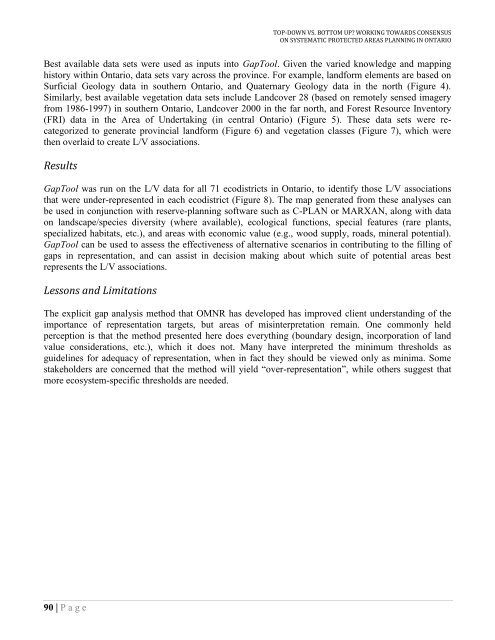Top-Down vs. Bottom Up: Working Towards Consensus ... - CASIOPA
Top-Down vs. Bottom Up: Working Towards Consensus ... - CASIOPA
Top-Down vs. Bottom Up: Working Towards Consensus ... - CASIOPA
- No tags were found...
You also want an ePaper? Increase the reach of your titles
YUMPU automatically turns print PDFs into web optimized ePapers that Google loves.
TOP-DOWN VS. BOTTOM UP? WORKING TOWARDS CONSENSUSON SYSTEMATIC PROTECTED AREAS PLANNING IN ONTARIOBest available data sets were used as inputs into GapTool. Given the varied knowledge and mappinghistory within Ontario, data sets vary across the province. For example, landform elements are based onSurficial Geology data in southern Ontario, and Quaternary Geology data in the north (Figure 4).Similarly, best available vegetation data sets include Landcover 28 (based on remotely sensed imageryfrom 1986-1997) in southern Ontario, Landcover 2000 in the far north, and Forest Resource Inventory(FRI) data in the Area of Undertaking (in central Ontario) (Figure 5). These data sets were recategorizedto generate provincial landform (Figure 6) and vegetation classes (Figure 7), which werethen overlaid to create L/V associations.ResultsGapTool was run on the L/V data for all 71 ecodistricts in Ontario, to identify those L/V associationsthat were under-represented in each ecodistrict (Figure 8). The map generated from these analyses canbe used in conjunction with reserve-planning software such as C-PLAN or MARXAN, along with dataon landscape/species diversity (where available), ecological functions, special features (rare plants,specialized habitats, etc.), and areas with economic value (e.g., wood supply, roads, mineral potential).GapTool can be used to assess the effectiveness of alternative scenarios in contributing to the filling ofgaps in representation, and can assist in decision making about which suite of potential areas bestrepresents the L/V associations.Lessons and LimitationsThe explicit gap analysis method that OMNR has developed has improved client understanding of theimportance of representation targets, but areas of misinterpretation remain. One commonly heldperception is that the method presented here does everything (boundary design, incorporation of landvalue considerations, etc.), which it does not. Many have interpreted the minimum thresholds asguidelines for adequacy of representation, when in fact they should be viewed only as minima. Somestakeholders are concerned that the method will yield “over-representation”, while others suggest thatmore ecosystem-specific thresholds are needed.90 | P a g e


